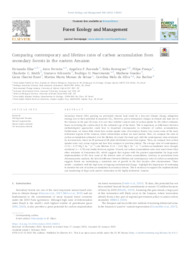Comparing contemporary and lifetime rates of carbon accumulation from secondary forests in the eastern Amazon.
Comparing contemporary and lifetime rates of carbon accumulation from secondary forests in the eastern Amazon.
Author(s): ELIAS, F.; FERREIRA, J. N.; RESENDE, A. F.; BERENGUER, E.; FRANÇA, F.; SMITH, C. C.; SCHWARTZ, G.; NASCIMENTO, R. O.; GUEDES, M.; ROSSI, L. C.; SEIXAS, M. M. M. de; SILVA, C. M. da; BARLOW, J.
Summary: Secondary forests (SFs) growing on previously cleared land could be a low-cost climate change mitigation strategy due to their potential to sequester CO2. However, given widespread changes in climate and land-use in the Amazon in the past 20 years, it is not clear whether current rates of carbon uptake by SFs reflect estimates based on dividing the carbon stock by the estimated age of the forest. This is important, as differences between methodological approaches could lead to important discrepancies in estimates of carbon accumulation. Furthermore, we know little about how carbon uptake rates of secondary forests vary across some of the most deforested regions of the Amazon, where reforestation actions are most needed. Here, we compare the rates of carbon accumulation estimated over the lifetime of a stand (by stand age) with the contemporary rates estimated by recensus data, based on 28 permanent SFs plots distributed across four regions. Then, we compare how carbon uptakes rates vary across regions and how they compare to previous studies. The average rates of contemporary (1.23 ± 0.57 Mg C ha?1 yr?1) and lifetime (1.14 ± 0.63 Mg C ha?1 yr?1) carbon accumulation were strongly correlated (r = 0.78) and similar between regions. Overall, our carbon accumulation rates were much lower than other estimates of Amazonian SFs, which suggests that regions with the greatest opportunities for large-scale implementation of SFs have some of the slowest rates of carbon accumulation. Contrary to predictions from chronosequence analysis, the lack of difference between lifetime and contemporary rates of carbon accumulation suggests forests are maintaining a consistent rate of growth in the first decades after abandonment. These results?combined with the high rates of ongoing environmental change - highlight the importance of continuing to monitor the rate of carbon accumulation in secondary forests. This is necessary to support the implementation and monitoring of large-scale passive restoration in the highly-deforested Amazon.
Publication year: 2022
Types of publication: Journal article
Unit: Embrapa Eastern Amazon
Observation
Some of Embrapa's publications are published as ePub files. To read them, use or download one of the following free software options to your computer or mobile device. Android: Google Play Books; IOS: iBooks; Windows and Linux: Calibre.
Access other publications
Access the Agricultural Research Database (BDPA) to consult Embrapa's full library collection and records.
Visit Embrapa Bookstore to purchase books and other publications sold by Embrapa.

